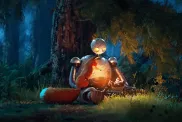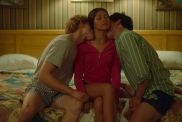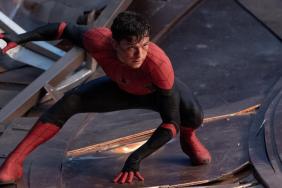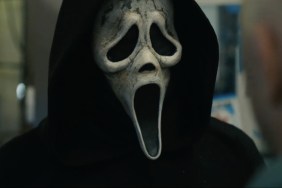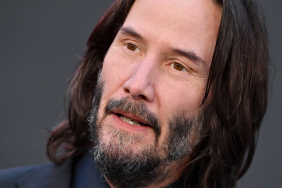Tom McCarthy is one of the rare breed of character actors who has successfully made the transition into writing and directing when his debut The Station Agent premiered at the Sundance Film Festival in 2013, eventually winning a BAFTA and Independent Spirit Award. His follow-up The Visitor received a similar amount of acclaim including an Oscar nomination for its star, Richard Jenkins.
Having ably found a way to mix humor and drama in his earlier films, McCarthy is now trying his hand at more of a high-concept comedy with The Cobbler, which pairs him with an unlikely star in Adam Sandler, who plays Max Simkin, a cobbler on the Lower East Side of Manhattan who discovers a stitching machine that allows him to wear the shoes he repairs and literally become the person to whom the shoes belong. At first, Max uses it to accomplish personal goals like making his mother happy by becoming his long-absent father, but then he starts to use his customer’s shoes to take on bigger things.
Having lived on the Lower East Side where the majority of McCarthy’s latest film takes place, I really enjoyed how the neighborhood was used as part of the story, as Max eventually has to take on a real estate broker (Ellen Barkin) wanting to tear down an old building to replace it with upscale condos. Sandler’s supporting cast includes the likes of Dustin Hoffman, Steve Buscemi, Method Man, Dan Stevens and many more.
ComingSoon.net got on the phone with McCarthy a couple weeks back to talk about the film, working with Sandler in particular, as well as using the traditions of the Lower East Side as its central plot and also talking briefly about his next project, Spotlight.
ComingSoon.net: I got to see this back at the Toronto International Film Festival with a real audience, which is so rare these days. It played really well and was much more fun to watch than the screener I watched earlier this week.
Tom McCarthy: I was just going to ask you. I know, man. I felt like they had a press and industry screening a few days before and they were like, “Whoa, what happened?” and then I saw it with an audience on premiere night and there was 1500 people who just totally connected with the movie. I was like, “Oh, this is great. This is why I made the movie,” and it felt really nice to see it with that audience and see how much fun they were having with it.
CS: I really don’t know much about the movie. I know it was co-written by Paul Sano, so did you two write it together or was it a screenplay he wrote and then you took over when you decided to direct it?
McCarthy: No, no, Paul’s an old friend of mine, and I called him and said, “I got this crazy idea. Do you want to write it with me?” and he said, “Sure, what is it?” and he jumped on. We just started meeting all the time and just talking about it just you know, (having) a burger here, beer there, go for a walk in the Lower East Side together where my office is and where he lived. We just talked about this movie a lot–what it could be, what it might be—and then we started outlining and writing it and it all happened pretty quickly after that.

CS: Compared to some of your other movies, it seems fairly high concept. You take the proverb about “walking in someone else’s shoes” and you go with it from there. Did you feel it was more high concept than some of your other movies or a departure from previous films?
McCarthy: I think without question. I was in a place where I wanted to just try something different. I really wanted to just play a little bit with tone and genre and style, and just follow the story. Just let it go, and just have some fun. I don’t know why, but whenever I’m making a reference to this movie, I was like, “I just want to make a movie where if I was filming the audience’s faces throughout the movie, they would really run a gamut of emotions, from fear to (being) touched to sweet to laughing to something else. I just had this image that I just wanted to make an entertaining, fun movie based on this idea of this particular person, this cobbler. What it became as we were writing it was really just fun and I think we just kept leaning into it and saying, “Let’s just trust it and go for it.” Ultimately, I think the movie reflects that.
CS: I have to admit that I have a little bit of a soft spot for the movie since I live on the Lower East Side and the whole movie was shot in my neighborhood.
McCarthy: Oh, that’s cool, man. Yeah, great. So we were all over there and it was great. When Sandler came into town to rehearse, we just spent a couple days just walking around that neighborhood, and popping in on different cobblers in all the different areas and different guys. He immediately got so into it because of that. We took him over to the Tenement Museum, which is awesome. I don’t know if you’ve ever been because it’s in your neighborhood and perhaps you don’t do that.
CS: I actually have done that with friends coming into town to visit.
McCarthy: It’s great, right? I love it. So we really got into it, and Paul and I really enjoyed researching the history of it and felt like that neighborhood’s just holding on to its last vestiges of the old neighborhood. I think it’s kind of a special place for that reason.
CS: Having lived here 22 years, I totally agree with you. I’ve seen the old buildings being knocked down and replaced by these ten-story monsters being put up in the middle of these four-story walk-ups. How do you end up with Adam Sandler? It’s an interesting double-edged sword because he has a certain number of fans he can bring into theater but film critics generally hate him. I feel like no matter what he does, film critics are going to slam him.
McCarthy: (laughs) I’m just waiting for someone to write an article about why people feel so vitriolic towards him on the critical side. Maybe it’s because he’s been very successful in doing what he does and hasn’t really concerned himself with that critical response as much. I didn’t know him at all going into this. I knew some of his movies–I didn’t know them all. I certainly grew up with him even though we’re the same age, to some extent, watching a lot of his stuff. He’s been doing it a lot longer than I was, but to me, he was just the right guy to play the role. His look and his type and his age and everything I just believed it. There were many times when I was editing this movie, when I thought, “Man, I wish he wasn’t Adam Sandler” because it would be great to achieve this with somebody we didn’t know. Or to show this in a place where they didn’t know who he was and see what the response for his performance would be, because he’s pretty f*cking great, that guy. Also, he’s really open-hearted, and I don’t mean just as a person—because he is. He’s a tremendously nice guy and a very generous guy, but just in terms as an artist. He just works really hard and he takes it seriously, and he loves it and you can just do that. You can really feel when someone just loves what they do, and they work hard at it. He was just a total joy to collaborate with, genuinely.

CS: I was curious about working with him as an actor, because for his own stuff, he’s very hands-on, often co-writing and producing the movies, so I was wondered what it’s like working with him as an actor.
McCarthy: I think he just really enjoyed doing it. I think he trusted me and I think occasionally, he just enjoys kicking back. Not to say that he didn’t have thoughts about scenes and character stuff and all that, because he did, but for the most part, he just felt like I knew what I was doing, and he was going to trust that. I think he’s an actor that knows that there are times when you gotta let it go. You can’t always just do everything, and I think in trying to find this character, he just let it go and that’s a good thing.
CS: You also have a lot of other actors like Method Man, not doing their Sandler impression, but basically stepping in for him, pardon the pun. Can you talk about casting some of those other actors to have them portraying Sandler as them? (If you know what I mean)
McCarthy: I think I do, but I feel that once we got Adam in place, I kind of understood the movie we were making, that’s sort of how I saw it, and then all these other pieces fell and like Buscemi made perfect sense. Meth made perfect sense to me. I’d worked with him a bit on “The Wire” but we didn’t intersect, and I just thought, “Here’s a guy who can be hugely funny and then be super-scary” and I kind of wanted that. I wanted to push that in this movie. It’s funny because I called Adam and said “What do you think about Buscemi?” and he’s like, “Come on, he’s Busch, I love him. You know that.” I kind of spaced on how long those guys had been working together, and I was like, “Oh, yeah, of course.” That sat well with their relationship in the movie. Really, a lot of it came together very quickly. The one guy we couldn’t cast was Dustin’s part, because we couldn’t decide. I think it was Adam who was like, “Who do you think would really be perfect?” and I was like, “You know who would be perfect? Hoffman.” And he was like, “Let’s ask him–I’ve always wanted to work with him!” And we did, and we talked him into it, it was great.
CS: It must be daunting to make a movie with such a huge cast and so many different characters, so when you were writing the screenplay, were you nervous about how many characters had to be cast? I think some of your other movies have been smaller, even “Win Win.”
McCarthy: Yeah, it’s funny you say that because then I turned around and did Spotlight, which I’m editing now and that also has a huge cast where I think Cobbler has a smaller big movie feel, right? It feels like a smaller movie in some ways, but then it’s got this story and these characters that just keep coming and coming and coming. It kind of snuck up on me a little bit, to answer your question. Then you cast those first five, six, seven roles and usually you’re done, but then you realize, “We still have people to cast.” It was fun and we had a good time with it. You got all these wonderful actors coming in for a couple days here and there. Dan Stevens coming in for a couple days, Yul Vazquez, all these great actors. That’s the fun part about moviemaking.
CS: I have to say that seeing Yul trying to walk in high heels had me laughing as hard as anything else in the movie.
McCarthy: Yeah he’s great in there and those heels were for real. We were shooting that scene with Adam and Yul and Cliff in his house where he impales him with the heel. That thing was like a weapon not to be messed with. (laughs)
CS: It’s interesting to have a movie where an hour into it, Ellen Barkin shows up. I think a lot of your movies have characters esbablished early on including the supporting roles, so this is very different in that it’s Adam’s movie but has others showing up throughout.
McCarthy: Yeah, I think it’s the fact that she comes on late in such a full way, you mean? Look, in some ways, it’s a straight-forward fun movie, but we were really challenged by it, both as writers and as filmmakers and storytellers. I think this was one of the elements that we kind of hinted about this woman that we don’t meet until much later in the movie, and then she’s sort of the face of what I consider one of the great scourges of modern society, the real estate developers, who just don’t give a sh*t about anything but making money and they raze neighborhoods in the guise of advancement of some sort, but really, it’s just about making money. Ellen just had this incredible quality and is fun to watch. You believe that she’s a tough gal who pulled herself up by the bootstraps and made a name for herself and probably came from that community at one point before moving out of the city. It’s always tricky to do, to bring characters in like that and I feel almost like at that point in the movie it becomes a real caper movie. There’s a shift tonally and I think that was something we were certainly playing with and exploring and having fun with.

CS: I was also curious about the Jewish aspect to the movie both with the opening sequence, which sets up the myth of the cobbler and also the music. Can you talk about getting into that and trying to get it right?
McCarthy: Yeah, that’s kind of based on the history, right? Immediately, when we talk about this character, we’re like, “Where does this come from in the past?” and investigating the Lower East Side and the different neighborhoods. That would have been a very Jewish neighborhood with a lot of Eastern European Jews were coming over at that time and settling in the lower East Side. So that scene would have been very common. That was something that we discovered when we were researching it at the Tenement Museum about the meetings that would happen late at night in a lot of these basements over different issues and sorting out the political and social issues of the time, which shockingly are very similar to ours, in this case a tough real estate developer who is driving them all crazy and driving them out of business. These guys decided to take action and reach out to their friendly neighbor cobbler. I think Paul and I really just had a lot of fun researching and trying to get that right and finding the right actors that speak Yiddish. Luckily, there’s still the thriving Yiddish (community) here in New York City. We really felt that it was a fun and interesting way to open the movie. Early on, to that end, we started experimenting with music of that period and of that people and it felt very right, so when I sat down with John Debney to talk about the movie, that was a heady flavor. We didn’t want to overdose on it, but we certainly wanted to keep that sound alive and let that infuse our score as much as possible.
CS: The movie ends in a way that’s almost setting up a whole universe of tradesmen with different skills, so was that something you wanted to set up or was it just a tease for people who see the movie to think about other things?
McCarthy: We kind of just did that. I think at the end we just felt like, “We’ll see.” If it works and we like it, we’ll revisit it, but I think it really just felt like it was where the movie wanted to go. I think it’s something that people can relate to. Look, a lot of times you go into a superhero movie and you know you’re seeing a superhero movie. You feel like “Okay, let’s get to it” and you watch a guy become a superhero and you know it’s coming the whole time. This movie felt almost like a superhero movie in reverse, because we really didn’t set out to do that but it just kept pushing us in that direction and there was an element to it. It felt right in terms of it being a fable and that kind of genre a little bit. But yeah, we had a good time leaning into that but we had no plans beyond this.
CS: It’s funny because these days, superhero movies are almost always a prequel or set-up to something else rather than being their own movies with a beginning, middle and end.
McCarthy: Exactly, exactly.
CS: What about this movie “Spotlight” which also seems very different from what you’ve been doing, maybe more serious? I know it’s about the Catholic Church, but is there any vestige of the Tom McCarthy we’ve seen in your other movies or is it something completely different?
McCarthy: Well, I also co-wrote that with another guy, Josh Singer, and I think whenever you bring in another writer, you bring in another element or degree, but I don’t know. Certainly, I always have trouble quantifying my movies. First of all, it’s based on a true story, so it’s the first time I did that, and it had a real investigative sort of procedural engine to it because it’s about this big story. But I think at the same point it’s also a very human story about some very real people dealing with something that was very difficult. I’m really excited with how the movie is coming together and I’m excited to share it.
CS: How far along are you? Just in the editing phase right now?
McCarthy: Yeah, full-time. It might come out this year, but we don’t know yet. I gotta finish it first.
The Cobbler opens in select cities on Friday, March 13.
The Cobbler
-
The Cobbler

-
The Cobbler

-
The Cobbler

-
The Cobbler

-
The Cobbler

-
The Cobbler

-
The Cobbler

-
The Cobbler

-
The Cobbler

-
The Cobbler

-
The Cobbler

-
The Cobbler

-
The Cobbler

-
The Cobbler

-
The Cobbler

-
The Cobbler

-
The Cobbler

-
The Cobbler

-
The Cobbler

